If you’re looking for minimal pairs activities for speech therapy you’ve come to the right place!
Below I’ve outlined how to use minimal pairs for phonological disorders as well as gathered free worksheets and materials to use during phonological interventions.
Phonological Interventions
Two frequently used phonological interventions for a child with a communication disorder are the Cycles Approach and the Minimal Pairs Approach.
Today we will be discussing the Minimal Pairs Approach that you can use with your phonology students.
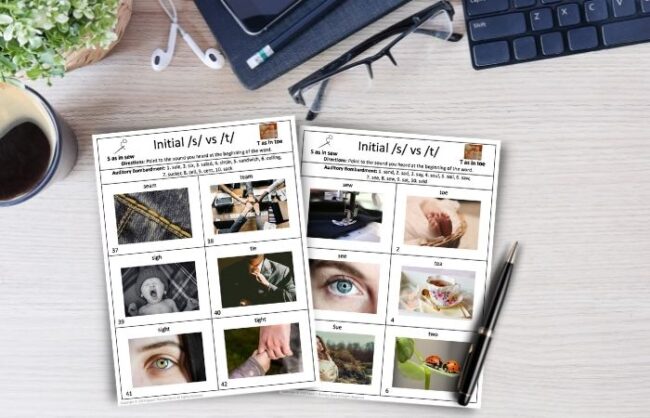
Phonological Processes
If you want to learn about the different phonological processes be sure to check out our handy chart of typical phonological processes and atypical phonological processes.

Target Words
When working on minimal pairs, start by selecting a phonological process to work on and then pick out minimal pairs to work on that specific phonological process.
For example, if you want to work on the phonological process of stopping (the phonological process when a child produces a stop consonant /p, b, t, d, k, or g/ in place of a fricative /f, v, th, s, z, sh, ch/ or an affricate sound /j/) then you could use the minimal pairs such as “fan” vs. “pan”.
This is when the child changes the manner of articulation. The manner of articulation is when a sound is made with a short burst of air that is then stopped such as the /p/ sound vs. a sound that has a more continuous flow of air such as the /f/ sound.
Continuing with the example of the phonological process of stopping then you would want to target the sounds /p, b, t, d, k, or g/ vs. /f, v, th, s, z, sh, ch/ or /j/.
Another example would be the phonological process of final consonant deletion (this is when a child omits the final consonant off of a word). For example, saying the word “bee” vs. “beak”.
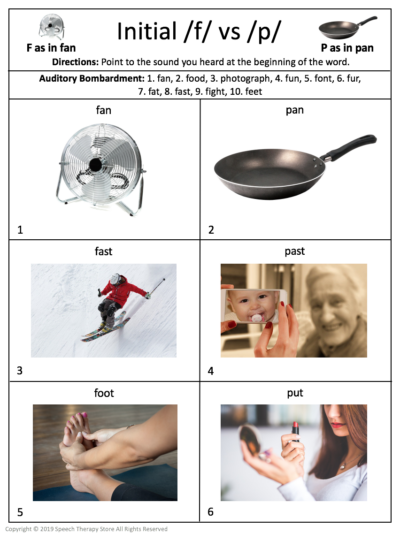
Minimal Pairs Therapy
When a child produces multiple sound disorders speech-language pathologists typically approach the sound errors from a phonological approach vs. an articulation approach.
One simple way to work on phonological remediation is to use minimal pair approaches.
Select Minimal Pairs Target: A speech therapist will typically have their first session using meaningful minimal pair intervention to begin by selecting 3-5 paired words to focus on.
You will want to select the target words based on the child’s speech sound disorder. In the example below the child is struggling with producing bilabial stops.
For example, if the child is working on bilabial stops their 3-5 minimal pair targets might be, pan/fan, past/fast, put/foot, pork/fork, and fade/paid.
Review Word Meanings: The speech therapist will then begin by making sure the child or client knows the meaning of the words containing their speech sounds prior to working on their production of minimal pair words.
For example, if you continue with the words used above you will want to discuss and review the meaning of the words “pan” vs. “fan”.
Auditory Discrimination: Next ask the child or student to point to the visual cue or hand you the picture of the word you say in order to work on auditory discrimination. This will tell you if the child can hear the difference between the single phonemes of /p/ vs. /f/.
For example, if you place the following single words (pan/fan, put/foot, pork/fork) in front of the child and then say, “point to the word fan”. Does the child point to the word “fan” or the word “pan”.
If the child points to the correct words when you say them aloud then the child can hear the difference. If the child points to the incorrect word then you will need to correct them and say this is the word and this is that word’s definition.
Auditory Bombardment: If the student is struggling to hear the difference during the auditory discrimination task you could also use auditory bombardment by pointing to the words and producing each word at the word level correctly allowing the child or student multiple exposures to the sound while it is being correctly produced.
For example, you could point to the word “pan” and say, “This is the word pan. A pan is for cooking. I keep my pans in a cabinet. This is the word pan.” Next, you could move on to the word “fan”.
Have the Student Use the Correct Production: It should also be mentioned that you will want to make sure that the child or student can make their incorrect sound correctly using correct sound placements prior to asking them to create their own sentence using the minimal pairs.
During this step have the student tell you which word to pick up. If you pick up the wrong card you can then remind them of the sound placement for that word they were trying to produce.
For example, if they tell you to pick up the word “pan” but really meant to say the word “fan” you could use that opportunity to review where to produce that sound in the mouth. Further helping the student recognize the difference between the minimal pair words.
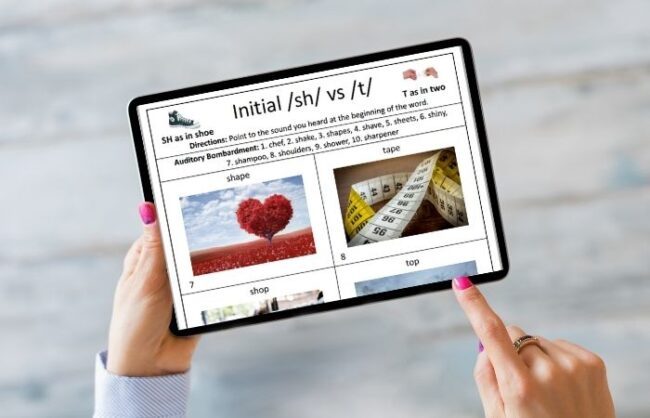
SEE ALSO: 430+ Free Multisyllabic Words List Activity Bundle

Free Minimal Pairs Activities for Speech Therapy
I’ve gone ahead and gathered a list of worksheets and materials below for the busy slps to use during minimal pairs therapy.
I know school budgets can be tight so here is a list of free resources.
Boom Cards
Boom cards are a perfect way to work on minimal pairs activities for speech therapy because they include picture cards plus they are fun and interactive. Here are a few that I found from the tpt store.
- Th-F Minimal Pairs Boom Cards™ Interactive | Distance Learning by Adventures in Speech – This is a set of Th-F initial and final position minimal pairs boom cards. They are fun, interactive and clear! There are 12 pairs.
- {FREEBIE} Cluster Reduction Minimal Pairs | Boom Cards™ | Distance Learning by Kristine Lamb – Use this free resource to help your students work on cluster reduction of minimal pairs. This targets /R, S, L/ blends.
- Hide & Seek Speech Minimal Pairs r/w – School Theme – Boom Cards by Little Speech Shop – In this game, students will find nine objects hidden beneath intersecting squares by naming the target words in the row above and the column on the side. This is an engaging and interactive game.
- Free /sw/ CR Minimal Pairs Hide & Seek Speech – Donut Theme – Boom Cards by Little Speech Shop – In this game, students will find nine objects hidden beneath intersecting squares by naming the target words in the row above and the column on the side. This is an engaging and interactive game.
- FREE k/t Minimal Pairs – Hide and Seek Speech – Space Theme – Boom Cards by Little Speech Shop – In this game, students will find nine objects hidden beneath intersecting squares by naming the target words in the row above and the column on the side. This is an engaging and interactive game.
- Free ng/n Minimal Pairs Hide & Seek Speech – Easter Theme – Boom Cards by Little Speech Shop – In this game, students will find nine objects hidden beneath intersecting squares by naming the target words in the row above and the column on the side. This is an engaging and interactive game.
- FREE Minimal Pairs Sort F vs. TH – Boom Cards by Sweetie Speech – Do you have a student that substitutes F for TH? Then these boom cards are for you! The set includes 10 pairs to sort.
- S and SH Minimal Pairs Boom Card™ FREEBIE by Teach Speech 365 – Help your student practice s and SH minimals pairs with this free deck! There is audio included, so students hear the correct sounds. There are 12 cards total.
Picture Cards
If you’re on the hunt for minimal pair cards or minimal pair pictures here are a few worth checking out.
Using picture stimuli can help the student differentiate that the two sounds create two different words.
For example, sand vs. band would be two different pictures.
- Minimal Pair Picture Cards /k/ vs /t/ by Mrs. W’s Speech Spot – Practice K and T sounds in these 6 minimal pair picture cards.
- TH vs. F Minimal Pairs Flashcards {FREEBIE} by Kiwi Speech – These 30 flashcards use words and pictures to practice TH and F minimal pairs.
- Articulation: Minimal Pairs K and G, T and D, CH and SH by Ms. Gardenia’s Speech Room – Your students will love these butterfly themed flashcards! Work on K/G, T/D, and CH/SH minimal pairs.
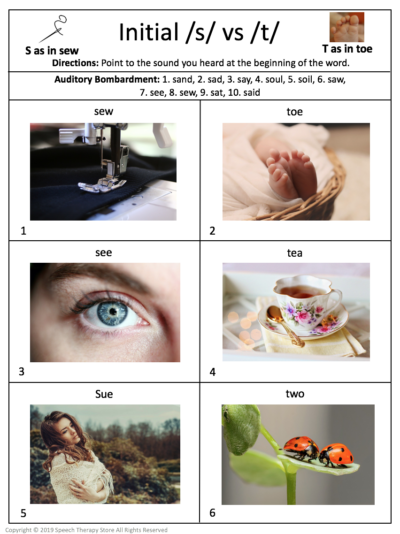
Minimal Pairs Activity Sheets
Here are a few minimal pairs activities for speech therapy that include pairs of words.
- /b/ & /p/ Minimal Pairs Matching Worksheet & Activity: Initial Position by Eat Sleep Speech – This work sheet is printable and downloadable. Practice minimal pair words /r/ and /w/ in the initial position.
- FREE Minimal Pairs Voiceless TH & F – Initial & Final Positions of Words by Speech Therapy Tools -This is a set of six minimal pair cards in the initial position and also a set of six minimal pair cards in the final position. Practice TH and F minimal pairs with your students!
- Minimal Pairs K and T Cut and Paste Activity by MsMaxSLP – This is an engaging and interactive cut and paste activity to address K and T minimal pairs!
- Minimal Pairs Smash Mats for Articulation & Phonology FREEBIE by Jill Shook SLP – Smash Mats can be used with playdough or coloring to help kids have fun, stay busy and practice their minimal pairs! This is a great worksheet to send home with students.
- S-SH Minimal Pairs Put the Mittens on the Penguins by PomKat Speech – Students love practicing S and SH minimal pairs while playing with a cute and engaging penguin!

Bilabial Stops
The bilabial stops sounds are /p/ and /b/. Using minimal pair words to work on bilabial stops can look like “pan” vs. “van”.
- Stopping Phonological Process: What is it? [Free Worksheets] by Speech Therapy Store – Use these resources for reducing the stopping phonological process.
- /f/ vs /b/ Minimal Pair Flashcards by SaLT Resources by Laura – These are a great resource to practice stopping of F and B.
- P/T Minimal Pairs by SaratheSpeechie – Have students practice P and T minimal pairs in both final and initial positions with this activity.
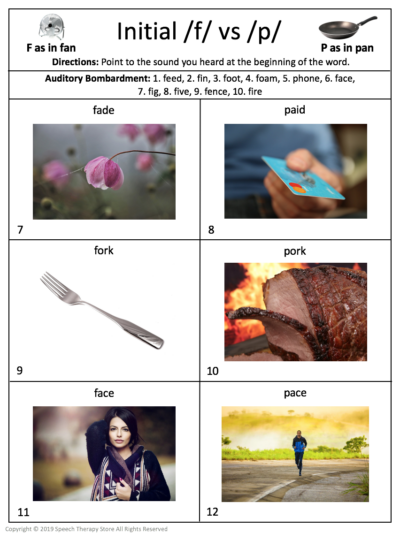
SEE ALSO: Best Handout for Phonological Processing Disorder Therapy
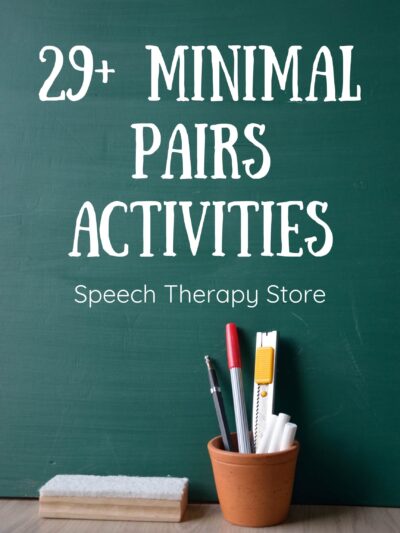
Phonological Group: Minimal Pairs Activities Speech Therapy
Here are a few minimal pairs activities for speech therapy that focus on different specific phonological processes.
Consonant Cluster
Consonant cluster reduction is when a consonant cluster, two to three consonants occurring in a sequence in a word, such as “sp” in the word “spot” or “st” in the word “stop”, are reduced to a single consonant through deletion.
For example, “pider” instead of “spider” or “top” for “stop”.
Here are a few resources worth checking out if you have a child or student working on cluster reduction.
- FREEBIE Cluster Reduction Minimal Pairs | Boom Cards | Distance Learning by Kristine Lamb – Students use playdoh to move and choose their answers! This resource includes cluster reduction for /r, s, l/ blends.
- Free Winter Speech Therapy Dot Art: Consonant Cluster Reduction (S Blends) by Ausome Speech -Print these sheets and practice consonant cluster reduction for S blends. There are 100 targets on each page. Make it interactive by using dot art, mini erasers, paint markers, stickers or coloring.
- FREE Spring Articulation Dot Art: Consonant Cluster Reduction (/L/ Blends) by Ausome Speech – Print these sheets and practice consonant cluster reduction for S blends. There are 100 targets on each page. Make it interactive by using dot art, mini erasers, paint markers, stickers or coloring.
- FREE Leveled Phonology Flipbook: Cluster Reduction of ST- & SP- Blends by Kayla SP – This is a flip book that can be used to practice phonological processes at all levels.
Initial Consonant Deletion
Initial consonant deletion is when a child leaves off a consonant from the beginning of a word.
For example, saying “ay” for the word “say” or “oon” for the word “soon”.
I’ve gone ahead and gathered a few resources below that you might find helpful when working on initial consonant deletion using minimal pairs therapy.
- Initial Consonant Deletion or Collapse: Animated story by Karen Pardyjak – This is a short story written to highlight the fact that using a specific initial consonant in CVC words changes the meaning. The story is an animated video.
- Initial & Final Consonant Deletion! Print N’ Go! 32 Squares by Speedie Speechie Supplies – This freebie includes 32 squares and hand drawn worksheets. Students draw a line from the word thats being articulated to the correct pronunciation.
- Initial Sound Deletion Game Pack for Phonemic Awareness by Phonolovable Literacy – The focus of these fun, interactive games and activities is initial consonant deletion.
Velar Fronting
Velar fronting is when a child substitutes a back velar sound /k/ or /g/ for a sound that is made in the front of the mouth the /t/ or /d/ sounds. (/t/ for /k/ and /d/ for /g/)
For example, saying “doh” for the word “go” or saying “tan” for the word “can”.
- Velar Fronting Minimal Pairs by Speech Tree Co – Use this resource for students to practice fronting K to T.
- Phonological Process FREEBIE: Velar Fronting Minimal Pair Match Up by Speech in the Sand – Print, laminate, cut and then match these minimal pair matching games to practice K and G.
- No Prep K & G Articulation Fronting Game Boards by No Prep Speech Mom – Use these game boards with students who have velar fronting of /k/ and /g/ sounds.
Multisyllabic Words
Using multisyllabic words can also help when working on phonological processes.
Multisyllabic words can also help with consonant cluster reduction by having the child or student say all parts of the multisyllabic word.
- 430+ Free Multisyllabic Words List Activity Bundle by Speech Therapy Store – This free resource comes with 135 pages with pictures and spaces to practice tapping out syllables.
- Reading Intervention-Decoding Multisyllabic Words-Prefixes-Freebie by Creative Pathways – This intervention provides teachers and parents with a strategy for teaching or reteaching valuable word attack skills to upper elementary students in a small group support model.
- {Freebie!} Decodable Multisyllabic Word Flashcards by Cassie Carr – This resources includes flashcards to practice decoding multisyllabic words.
- Multisyllabic Words Open Syllable Sort – PHONICS freebie by Emily Fontaine – This resource includes a word list, sorting mat and an extra freebie word list for reinforcement!
SEE ALSO: Stopping Phonological Process: What is it? [Free Worksheets]
Minimal Pairs Speech Therapy Bundle
- Stopping resource that includes the following minimal pairs /f/ vs. /v/, /s/ vs. /t/, /sh/ vs. /t/, /ch/ vs. /t/, /th/ vs. /t/, /th/ vs. /p/ by Speech Therapy Store – If you’d love to have a massive speech therapy bundle that includes minimal pairs then be sure to check out my minimal pairs resource. Each page also includes an additional 10 auditory bombardment words of the target sound.
- Minimal Pairs & More: Gliding | Speech Therapy | Phonological Disorders | Cycles by The Pedi Speechie – Use this print and go packet to target gliding! The teacher will reach the minimal pairs on the page and have the student point to the sound they hear. Each sound is paired with both a visual and written ‘sound descriptor’.
- FREEBIE /l/ & /j/ Minimal Pairs Jigsaw Puzzles – Speech Therapy Activity Game by The Speech Volcano – This is a fun puzzle to work on J and L sounds!

In Conclusion: Minimal Pairs Activities Speech Therapy
I hope you’ve found these minimal pairs activities to be helpful!
Do you have a favorite minimal pairs resource? Feel free to let me know in the comments below.
<< Be sure to check out my free stopping post and freebie! >>
Want Even More Minimal Pairs Activities for Speech Therapy?
- 21 Best Reinforcement Games for Speech Therapy
- 261+ Free Ideas for Digital Therapy
- 917+ Best Free Boom Cards for Speech Therapy
- 11 Free Articulation Games for Speech Therapy
- Best Free Interactive PDF for Speech Therapy All-in-One
Want the Best of the Bests?
Be sure to check out our most popular posts below!
- 21 Best Reinforcement Games for Speech Therapy / Teletherapy
- Best IEP Resources
- 71+ Free Social Problem-Solving Scenarios
- 430+ Free Multisyllabic Words List Activity Bundle
- 432+ Free Measurable IEP Goals and Objectives Bank
- 279+ Free Speech Therapy Digital Materials
- 179+ Free Speech Therapy Wh-Questions Printable

Rigoberto
Tuesday 17th of May 2022
Thank you for these amazing visuals.
Melissa Berg
Tuesday 24th of May 2022
Hi Rigoberto, Wonderful! Glad you like them! All my best, Melissa